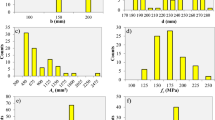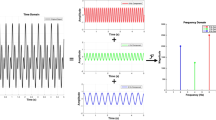Abstract
Steel frames are widely used in earthquake areas but the fragility analysis of the steel frames is a time consuming process. The fragility curves are generally obtained based on a large number of time history analyses. In order to better simulate steel frames, the material and geometric uncertainties are considered. The moderate earthquake records are selected as the earthquake samples. Then the seismic damages induced by these samples are obtained using Finite Element Analysis (FEA) program. An Artificial Neural Network (ANN) is trained by these seismic damage data. Then the trained ANN is used to predict the seismic damage of the steel frame. When the training data is enough, the method has high prediction precision. The fragility curves based on the ANN prediction are the same as that based on the FEA program.
Similar content being viewed by others
References
Alawadhi, E M. (2010). Finite element simulations using ANSYS Boca Raton: Taylor.
American Institute of Steel Construction (2005). Seismic provisions for structural steel buildings, Chicago: American Institute of Steel Construction.
American Institute of Steel Construction (2010). Specification for structural steel buildings, Chicago: American Institute of Steel Construction.
Amr S. Elnashai and Luigi Di Sarno (2008). Fundamentals of earthquake engineering, Wiley and Sons, UK.
Bakhary, Norhisham, Hong Hao, and Andrew J. Deeks (2007). “Damage detection using artificial neural network with consideration of uncertainties.” Eng Struct, Vol. 29, pp. 2806–2815, DOI: 10.1016/j.engstruct. 2007.01.013.
Gao, S., Zhang, Z., and Cao, C. (2011). “Road traffic freight volume forecast using support vector machine combining forecasting.” J. Software, Vol. 6, No. 9, pp. 1680–1687, DOI: 10.4304/jsw.6.9.1680-1687.
González, María P. and José L. Zapico (2008). “Seismic damage identification in buildings using neural networks and modal data.” Computers and Structures, Vol. 86, No. 2008, pp. 416–426 DOI: 10.1016/j.compstruc.2007.02.021.
Hamdia, K. M., Msekh, M. A., Silani, M., Vu-Bac, N., Zhuang, X., Nguyen-Thoi, T., and Rabczuk, T. (2015). “Uncertainty quantification of the fracture properties of polymeric nanocomposites based on phase field modeling.” Composite Structure, Vol. 133, pp. 1177–1190, DOI: 10.1016/j.compstruct.2015.08.051.
Hariri-Ardebili, M. A., Sattar, S., and Estekanchi, H. E. (2014). “Performance-based seismic assessment of steel frames using endurance time analysis.” Eng Struct., Vol. 69, pp. 216–34, DOI: 10.1016/j.engstruct.2014.03.019.
Huang, C. S., Hung, S. L., Wen, C. M., and Tu, T. T. (2003). “A neural network approach for structural identication and diagnosis of a building from seismic response data.” Earthquake Engng Struct. Dyn., Vol. 32, pp. 187–206, DOI: 10.1002/eqe.219.
Kalkan, E. and Kunnath, S. K. (2007). “Assessment of current nonlinear static procedures for seismic evaluation of buildings.” Eng Struct, Vol. 29, No. 3, pp. 305–16, DOI: 10.1016/j.engstruct.2006.04.012.
Karim, K. R. and Yamazaki, F. (2007). “Effect of isolation on fragility curves of highway bridges based on simplified approach.” Soil. Dyn. Earthquake Eng., Vol. 27, pp. 414–426, DOI: 10.1016/j.soildyn. 2006.10.006.
Lupoi, G., Franchin, P., Lupoi, A., and Pinto, P. E (2006). “Seismic fragility analysis of structural systems.” J. Eng. Mech, Vol. 132, No. 4, pp. 385–395, DOI: 10.1061/(ASCE)0733-9399(2006)132:4(385).
Martin T. Hagan, Howard. B. Demuth, and Mark Beale (2002). Neural network design, USA: Martin Hagan.
Pan, Y., Agrawal, A. K., ASCE, M., and Ghosn, M. (2007). “Seismic fragility of continuous steel highway bridges in New York state.” J. Bridge Eng., Vol. 12, No. 6, pp. 689–699, DOI: 10.1061/ASCE1084-0702 200712:6-689.
Pan, Y., Agrawal, A. K., ASCE, M., Ghosn, M., ASCE, M., and Alampalli, S., and ASCE, F. (2010). “Seismic Fragility of Multispan Simply Supported Steel Highway Bridges in New York State. I: Bridge Modeling, Parametric Analysis, and Retrofit Design.” J. Bridge Eng., Vol. 15, No. 5, pp. 448–461, DOI: 10.1061/(ASCE)BE.1943-5592.0000085.
Park, Y. J., Ang, A. H. S., and Wen, Y. K. (1985). “Seismic damage analysis of reinforced concrete buildings.” J. Struct. Eng., Vol. 111, No. 4, pp. 740–757, DOI: 10.1016/0045-7949(92)90132-J.
Parsaei Maram, Mohammad, K. Rama, Mohan Rao, and Ali Poursalehi (2013). “Anartificial neural network for prediction of seismic behavior in RCbuildings with and without infill walls.” International Journal of Modern Engineering Research, Vol. 3, No. 5, pp. 3071–1308.
Rafiq, M. Y., Bugmann, G, and Easterbrook, D. J. (2001). “Neural network design for engineering applications.” J. Comp. Struct., Vol. 79, pp. 1541–1552, DOI: 10.1016/S0045-7949(01)00039-6.
Rodriguez, Mario E. and Daniel Padilla (2009). “A damage index for the seismic analysis of reinforced concrete members.” Journal of Earthquake Engineerin, Vol. 13, pp. 364–383, DOI: 10.1080/13632460802597893.
Sterritt, Roy (2003). “Autonomic computing: The natural fusion of soft computing and hard computing.” IEEE, Vol. 5, pp. 4754–4759, DOI: 10.1109/ICSMC.2003.1245735
Topçu, I. B. and Saridemir, M. (2008). “Prediction of mechanical properties of recycled aggregate concretes containing silica fume using artificial neural networks and fuzzy logic.” Comput. Mater. Sci., Vol. 42, No. 1, pp. 72–82, DOI: 10.1016/j.commatsci.2007. 06.011.
Vu-Bac, N., Lahmer, T., Zhuange, X., Nguyen-Thoi, T., and Rabczuk, T. (2016). “A software framework for probabilistic sensitivity analysis for computationally expensive models.” Advances in Engineering Software, Vol. 100, pp. 19–31, DOI: 10.1016/j.advengsoft.2016. 06.005.
Wu, X., Ghaboussi, J., and Garrett, J. H. (1992). “Use of neural networks in detection of structural damage.” Computers & Structures., Vol. 42, No. 4, pp. 649–659, DOI: 10.1016/0045-7949(92)90132-J.
Yeung, W. T. and Smith, J. W. (2005). “Damage detection in bridges using neural networks for pattern recognition of vibration signatures.” Eng. Struct., Vol. 27, No. 5, pp. 685–698, DOI: 10.1016/j.engstruct. 2004.12.006.
Yun, C.-B. and Bahng, E. Y. (2000). “Substructural identification using neural networks.” Computers & Structures, Vol. 77, No. 1, pp. 41–52, DOI: 10.1016/S0045-7949(99)00199-6.
Zadeh, L. A. (1994). “Soft computing and fuzzy logic.” IEEE Software, Vol. 11, No. 6, pp. 48–56, DOI: 10.1142/9789814261302_0042.
Author information
Authors and Affiliations
Corresponding author
Rights and permissions
About this article
Cite this article
Liu, Z., Zhang, Z. Artificial neural network based method for seismic fragility analysis of steel frames. KSCE J Civ Eng 22, 708–717 (2018). https://doi.org/10.1007/s12205-017-1329-8
Received:
Revised:
Accepted:
Published:
Issue Date:
DOI: https://doi.org/10.1007/s12205-017-1329-8




